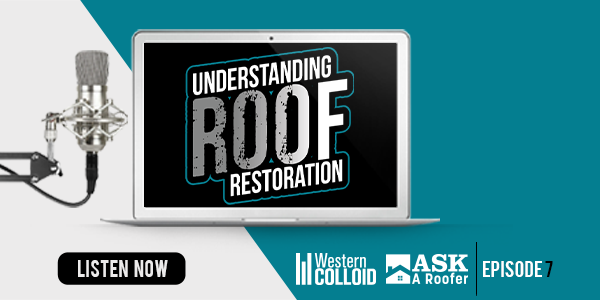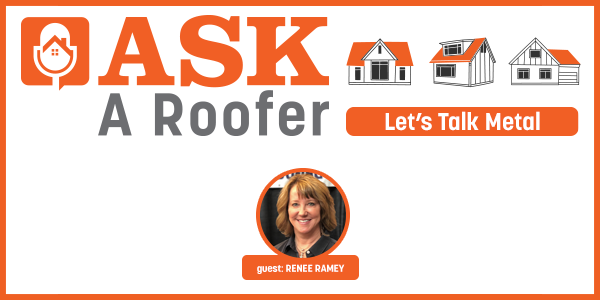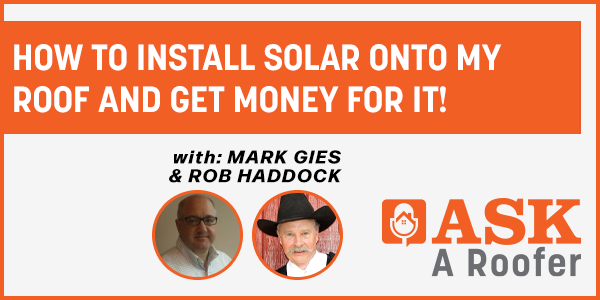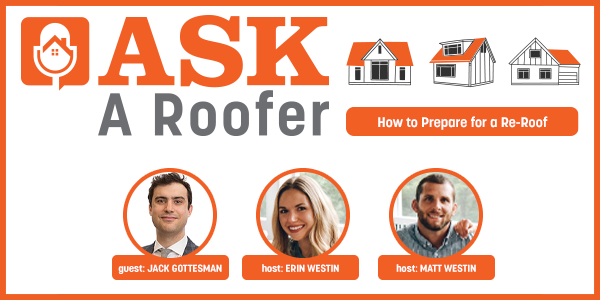Understanding Roof Restoration Episode 7 - Retrofitting Your Roof for Solar - PODCAST TRANSCRIPTION
June 2, 2023 at 6:00 a.m.Editor's note: The following is the transcript of a live interview with Greg Hlavaty and Hal Leland. You can read the interview below or listen to the podcast.
Karen Edwards: Hello and welcome to The Understanding Roof Restoration Podcast. I'm your host, Karen Edwards from askaroofer.com. The Understanding Roof Restoration Podcast dives deep into the topic of restoring roofs. As the popularity of roof restoration continues to grow, there are many questions that arise.
With a wide variety of roofing systems on existing buildings and many available restoration options, we turn to the experts at Western Colloid to answer your questions on roof restoration. Greg Hlavaty, Hal Leland, and the team at Western Colloid have been manufacturing and installing these systems for more than 50 years, and they have seen it all. We will tackle a different topic each month and answer questions submitted by you, our listeners.
Hello, everyone. I am Karen Edwards and I am super excited to welcome Greg Hlavaty and Hal Leland back to The Understanding Roof Restoration Podcast. Welcome, guys.
Hal Leland: Hey, good morning.
Greg Hlavaty: Glad to be here.
Karen Edwards: So we're going to talk about a topic that is really gaining in popularity, and that's solar. And especially you guys are headquartered out in California. California usually is leading the way with requiring solar, but also with offering some incentives and reasons why people might want to consider solar. And there's even been some federal incentives as well.
So we're seeing this more and more, but I think it's important as a building owner or even a contractor, what are some considerations that you need to think about before you just say, "Hey, I'm going to put solar on my roof."
Greg Hlavaty: It's a big deal out here in California, I have solar on my roof and many of the businesses around us have solar on them. Some of the energy companies actually lease rooftops like they lease ground as solar farms, big industrial buildings. They'll go up and put solar on it and give the building owner a portion of what they make on that. So there's a lot of solar being generated. There's a lot of solar being put on roofs. That's a great thing, I think.
But it is also, it can be a problem for the building owner because it's all about the solar when they're talking about it. But the reality is the solar is a passive thing. Once they put it up there, it's generating, it's going into the system. There's probably a little maintenance and what have you, but how does it affect your building? So often, especially when they first started out here with some of the energy companies, they'll go, "Oh, here's a great building. It's 150,000 square feet. Let's fill it with solar," right?
And the roof is 10, 12 years old. So either they'll put it on the way it is, or they'll do some maintenance and put it on. What they forget is they got the solar up there for 20 to 25 years, because that's kind of the life expectancy of today's solar. But what's the life expectancy of that roof you're putting it over? You got to remember that.
And so a lot of times they'll forget that, or they'll just do just a Band-Aid fix on it and they really need to get another 20, 25 years out of that roof to put the solar on. But all the money is put into the solar. And unfortunately, a lot of it was not put into roofs. Well, they've learned some of the lessons. So we've actually developed some of our best systems that Hal has taken to FM and tested, FM tests for a lot of things.
But in solar's case, it's really important that the impact, they call it hail tests, but really it's impact test. Because you have to remember, when you're going to be putting solar on your roof, you wonder how a hail test can come into it. Well, the reality is those guys are up there, there's screw guns, there's toolboxes, there's bars, and all the racking that the solar has put on, all that is being dropped and dumped on that roof. That's all impact.
And then they come up every so often and maintain that. And electricians are up there and what have you. So the integrity of that roof is key. So several of our systems that we sell in areas that have not only reinforced membranes, but have reinforced reflective coatings on the top of them, were originally developed when the solar started becoming a factor here. We knew we needed something to withstand the abuse that it's going to get when solar's being installed.
Karen Edwards: There's a lot of traffic on the roof, as you said, from time to time. So tell me a little bit more about the roof system that can withstand that much abuse.
Greg Hlavaty: Right. There's also different types of roofs that are showing up that they don't take solar real well over the long term. We've got a chain of department stores out here in the West that right off the bat, jumped on solar. They put new TPO roofs on them, and TPO's great and it works well when it's new. But the solar they put on them, being glass panels that collect dew and drip every night and have just the constant dripping every night from the dew, even in interior warm and dry areas, left channels, water channels that etched away a lot of that product and they needed to be redone much earlier than the expected life expectancy of that roof.
So the type of roof that you've got is a consideration. And then how long can you really get out of that roof? So one of the things that we do a lot of is they'll use one of our systems to bring that roof, whether it's a modified bitumen, a single ply roof that's already got some years on it, bring it up to, hey, we can make the life expectancy of that roof, the life expectancy of that solar. Because you can lift the solar re-roof, but there's a lot of cost in that. In some cases, there are some solar companies out there that will charge the same amount to lift and reinstall the solar as they did to sell them the solar in the first place.
Karen Edwards: Wow.
Greg Hlavaty: So you have to be careful there even when you're buying your solar. But we try to work hand-in-hand with several solar companies, but there are so many different configurations. There's solar that is laid on your roof and just is ballasted with weight and has feet or footprints that sit on the roof. And it's held there in place by weight. There's only a few protrusions that go through the roof where the electricity runs in. There's all different types of racking systems.
Seems like every month somebody sends me, "Hey, what do you think about this new solar panel attachment?" And some of them are attached rigidly and they have great details that have multi-layer bolts that are covered and embedded and cocked and all that stuff. So there's a big consideration.
Then there's a lot of different companies that make different attachments that can be some solar can lay flat right on your roof, which means you would definitely have to lift it to re-roof it. And some are up on racks that are above the roof. Luckily, and you talked about, and I think we'll talk a little more about it, about re-roofing if you already have solar. And some of this department stores we did, they were all on rack systems that sat about 18 inches off the roof and had a couple feet apart every row of solar.
So those were actually roofed in place. That solar was not moved. Well, we had a really good contractor that developed a technique to get underneath that solar and put a multi-ply reinforced acrylic surface system right on that. And just made a beautiful package for multiple stores and has worked out great and saved them a lot of money. But because they thought they were going to have to remove the solar to get a new roof.
So many times you have to. Sometimes if that solar's sitting right down on the roof and laying flat, you're going to have to lift it. So think about it before you install that solar, because that roof is where you're going to spend the money on. Solar, you can replace the panels down the road, you can fix the electrical connections. That roof is costly. And so many times they want to spend all the money on the electricity and the panels and ignore the roof.
Karen Edwards: That's kind of the most important thing if you're thinking about putting solar on there, is to understand, one, what kind of roof do you have? Two, what kind of condition it is in, and three, what the longevity, what the useful life that you have left of that existing roof? And then once you have the answers to those questions, then it's time to think about how can I bring my roof up to like-new condition? And that's where Western Colloid comes in with those options that are significantly less of an investment than a complete re-roof.
Greg Hlavaty: The solar installation companies that's selling the solar, they may have some knowledge of roofing or they may have a roofing contractor that is kind of the person that they work with. But what you have to remember is their incentive is in selling that solar and getting it on that roof. And if they have to tell you, "Oh yeah, this solar's going to be X amount of dollars and that roof, to bring it up, it may be the equal amount as the solar." They don't want to have to tell you that.
And not only that, most solar companies haven't been around as long as life expectancy of the roof. So they don't always know if that's the case, how long that's going to be. So in many cases, it's not a bad idea to get an independent other than the solar company. And not that they're bad, but their expertise is in their solar. And you want somebody that has expertise in that roof that will give you an honest opinion and say, "No," because there's some of them that we can do a pretty good condition, and then we might do one layer of polyester in an acrylic coating to give it the toughness. And sometimes they're pretty far gone and they need more, they need a pretty heavy system, a multi-ply reinforced on there to live the life of the solar.
Hal Leland: And most of the big box stores and stuff that we work with, most of the predominant customers for solar, Home Depots, these sort of thing, Lowe's, Amazon, they had their own roofing consultants. And that's where it starts, if they're doing new stuff. And even if they have existing buildings out there, they'll talk to that consultant and then we'll qualify the assembly or system that's going to go on either before it or post add for the solar system. So it works in different ways.
Greg Hlavaty: Right. And then the weight comes in, because the weight of solar can be significant. These are glass panels, there's all types of system. They're changing just like the computer industry did. And that over the years, that they're always being improved. They try to lighten them weight wise. And they do a good job of that, but they're still adding considerable weight so that you may need a consultant. That usually a solar company will have a consultant that can engineer whether they're can take the weight.
So the roof, just an overlay roof would be expensive and add more weight. And that's where our systems are also helpful in that they're extremely lightweight, less than a pound, in most cases, per foot. And so it's adding a very small amount to get a lot of years and will not significantly affect the overall weight of the system as long... Because sometimes they can get pretty marginal how much more weight a roof can take when you're putting the solar on it. So a lightweight system like this can be helpful. And you can see on our website, we have a lot of examples of our system under either before or after solar's installed.
Karen Edwards: And then the nice part, I guess, about having the Western Colloid system on the roof before the solar goes on, is that it's easy. It can be redone, I guess, brought back to life after 10 years or 20 years. And like you said, you're able to go around the panels.
Greg Hlavaty: Right.
Karen Edwards: They don't necessarily have to be detached and reset.
Greg Hlavaty: And it can be custom designed. We have some roofs where half of the roof gets it because of the angle of the roof and the slope and what have you. Maybe only half that roof is getting solar on it. And the other half of the roof is in decent shape. And with our systems, it can be designed where part of it gets the solar gets a beefier system than the rest of the roof that is doing pretty well.
So it can help save economically where you don't have to, if you were putting a single ply on or modified bitumen, you're going to put that on everything. This case, you can save some money on the part of the roof that is doing well and beef up the part that's going to get the abuse and the solar on it.
Karen Edwards: This podcast is brought to you by AskARoofer and Western Colloid, Fluid Applied Roofing. When you're looking for answers for your roof, what better place than askaroofer.com. If you are looking for answers on restoring your commercial, industrial or low slope roof, look no further than Western Colloid.
For over 50 years, they have been bringing old roofs, new life. Together, we're helping contractors, building owners, property managers, architects, engineers and consultants choose the best commercial roofing system. Find Western Colloid today on askaroofer.com.
Explain what you mean by beefier system. To me that means like thickness, toughness.
Greg Hlavaty: Right. Our systems can range from the very lightest, which is just a reflective coating, which is what most coating manufacturers sell. Acrylic or urethane or something like that. In our case, it would be an acrylic where they just put on, usually in the range of three gallons of the acrylic coating. That's right down there. That's just a maintenance coating for reflectivity. And to add some life, wearability to that roof as far as UV degradation and what have you, and cool the roof off, cool the building off.
But most of what we do is reinforce. So you step up into a one ply of reinforcement. Usually in our case, it's polyester fabric. In some areas, it's chopped fiberglass. It can be with people that have the right kind of equipment to spray chopped fiberglass.
But usually it's reinforced polyester fabric. And kind of the minimum system is a one ply of that polyester fabric in one of our coatings. Either our asphalt emulsion as a base, or in the acrylic surface coating. But then it can step up from there to two plies reinforcement, all the way up to three plies of reinforcement for the longest lifespan and the toughest.
When Hal goes to FM and tests the, that's where it's resists the largest impact resistance and what have you and can take the most abuse. And the other factor is, is that the acrylic coatings, and we've talked about this in some of our podcasts in the past, that some of the water based and acrylic coatings have gotten a bad name because of the lack of resistance to ponding water. And acrylics can withstand the equivalent of any coating out there, including silicone if they're put on right and reinforced.
And that's the secret, is when we get into these kind of systems, we don't just put on a 20 mill or 24 mill surface coating of acrylic, that acrylic gets a fabric reinforcement. Once you reinforce that acrylic, you're at 60 plus mills of product. Now you're to the equivalent of the high-end single plies, PVC, TPO, EPDM. You're up there in the 60 plus mills just for that reflective coating. So it's made to withstand the abuse that it's going to get.
Karen Edwards: You mentioned earlier the dew that forms and then drips and drips and was causing some problems with some of the other roofing systems. That's not an issue?
Hal Leland: All these big box stores, they're buying these TPO single-ply membranes. And they're great, but they're in these areas where we're having dripping water and sun beating on them, they're lasting about five years before the polymer's coming out of that sheet. And it's exposing the scrim, the polyester reinforcement.
Well, that doesn't happen with an acrylic. Acrylic's, they eat that up. So we went and we designed the systems to go over our TPO membranes, and it was a perfect fit for these solar applications because we can adhere directly to that membrane and we can do one, two plies coating only, and we can just rejuvenate and reinforce those areas.
We can actually go under the solar, we can do all the penetrations. It's a perfect fit. In Northern California, most of these assemblies are over TPO membranes and TPO membranes that are failing. So the Western Colloid [inaudible 00:18:48] applied systems, all-acrylic, polyester enforced. Asphalt emulsion polyester reinforced systems are just cost effective, perfect fits for this type of application.
Karen Edwards: It sounds like it. Now, is it true that new construction in California is requiring solar?
Greg Hlavaty: Yes and no. The government up there in its infinite wisdom, they thought if they mandated it, it would decrease the energy requirements. But most of that has been in residential. If you build new houses, I'm not sure that that's really flying yet because housing's already expensive. And then you add another 30 or $40,000 onto a house because they have to put solar on it, it has become a real problem. There's been some pushback. Most of that was in residential where they were requiring that.
Karen Edwards: Good to know. Good to know. But I do know with the recent Inflation Reduction Act, the one that passed, I believe last summer, there are some pretty good incentives that may have more building owners, when it's time to do something about their roof, looking at solar as well.
And you said you partner with some solar contractors. How are they bringing you in? If a building owner says, "Hey, I want to do solar," they're probably going to contact a solar contractor. Are they then contacting you?
Greg Hlavaty: Usually. It's case by case with our different roofing contractors. We have a couple of good roofing contractors in Southern California that work with two or three solar installers. And they like to use, they'll go to that roofing contractor who use our system underneath theirs. So it's a partnership between a solar contractor and a roofing contractor.
And in our case, we have several of them that work with some nice solar companies that install some... Like I said on our website, you can see some really beautiful solar installations. Because there's some liability issues there too. When you put a new roof on and then the solar guy comes on, puts that roof on, pokes some holes in it, and most of them want to repair that themselves. You've got a roofing contractor that's got a warranty on that roof, and me as a manufacturer that has a warranty on that roof. And then the solar guy has put that on, they need to work hand in hand because that solar guy needs to hand that roof back off to that installation roofing contractor so that he can bring that back up to our standards so that warranty isn't affected.
Because if it is a solar contractor who's not maybe playing a hundred percent by the rules, he gets it on, he does his own thing, he calks around all his protrusions and goes home and then there's a problem and the building owner calls us, "Well, we've got a roof and a warranty on it." "Yeah, but you had a solar guy put solar up here and none of these details were done back to standards." So you want your solar guy and your roofing guy working hand in hand so that the warranties stay in effect also, because the building owner can be the one hanging out there and left unsupported.
Hal Leland: I like to work directly with the roofing contractor, and that's what we do normally in Northern California. Because I think I've done, let's say I've done a thousand solar projects, I don't know that more than five are the same type of solar panels. There's so many out there, there's so many solar guys. And some come and some go, the constant in our world is the roofing contractor.
So the building owner's decided he wanted to use some sort of panel and had the right production for whatever he's doing. He's attracted to it and he's sold on it. And that solar guy finds a roofing contractor that knows how to put an assembly down. He picks us. We go up there and we're able to work, say there's 500 solar guys, we're able to work with every one of those panels and every one of those penetrations and applications, whether ballasted or bolted through the roof. So we're the kind of constant in this.
Karen Edwards: Mm-hmm. I like that. You're very universal. No matter what type of solar system is up there, you are that constant. You have the solution that will work for the roof. And I really like the information that you've mentioned about the warranty, Greg, because you don't want to get into a situation where there's finger pointing and saying, "Well, it's their fault. No, it's their fault, and it's not our fault." So by making sure that that roof is brought back to those standards after the solar installation, I think that's key. Very important.
Hal Leland: So most of these assemblies also, if I may interject. So these are 25-year panels, most of them all, right? So we're putting on minimum 20-year assemblies. And those aren't just 20 years and you're done, those are 20 years and then we recoat and we extend that warranty 10 years' at a time. So at that 20-year period, we go up there, we do all the detail work, we look for penetrations, we make sure everything's functioning properly. We put another couple coats of acrylic on top of that assembly and we extend that warranty for another 10 years. And we can do that for the lifecycle of the building, the structure. So we can actually outlive these solar panels.
Karen Edwards: That's fantastic. Good to know, good to know. So I'm going to just wrap it up and recap some of what we talked about today were, before you put solar on the building, always look at the type of roof, the condition of the roof, and consider a solution like Western Colloid that can bring that roof into a condition that will last, outlast, even the solar panels. And think about the warranty.
Make sure that after an installation, that that roof is brought back to a condition that you guys approve of to not void the warranty. I'm sure some people have been in that position. So it's exciting. We see more and more of the sustainable movement in solar. So I'm glad that there are solutions like Western Colloid that can make it, because solar's expensive. But having this option versus an entire re-roof actually can make it a little more affordable for building owners.
Next month, we are going to be talking about, this is going to be Hal's grand spotlight here because it's about FM. What does it mean when a system is FM approved, and what approvals should we care about? That's our topic for next month. But we are always looking for your questions.
If you have questions from building owners, if you have questions yourself, send them in to us. If we use your question, we'll send you something special, a nice treat. And you can listen to this podcast on askaroofer.com. You can listen to it on westerncolloid.com, or any platform where you listen to your favorite podcasts.
So Greg, Hal, thank you so much for talking all things solar today. I look forward to seeing you next month when we're going to be talking about FM approvals.
Hal Leland: Thanks, Karen.
Greg Hlavaty: Thank you.
Karen Edwards: Thanks. Bye-Bye.














Comments
Leave a Reply
Have an account? Login to leave a comment!
Sign In